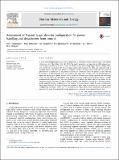| dc.contributor.author | Umansky, M.V. | |
| dc.contributor.author | Rensink, M.E. | |
| dc.contributor.author | Rognlien, T.D. | |
| dc.contributor.author | Labombard, Brian | |
| dc.contributor.author | Brunner, Daniel Frederic | |
| dc.contributor.author | Terry, James L | |
| dc.contributor.author | Whyte, Dennis G | |
| dc.date.accessioned | 2018-07-25T17:43:46Z | |
| dc.date.available | 2018-07-25T17:43:46Z | |
| dc.date.issued | 2017-04 | |
| dc.date.submitted | 2017-02 | |
| dc.identifier.issn | 2352-1791 | |
| dc.identifier.uri | http://hdl.handle.net/1721.1/117118 | |
| dc.description.abstract | A study of long-legged tokamak divertor configurations is performed with the edge transport code UEDGE (Rognlien et al., J. Nucl. Mater. 196, 347, 1992). The model parameters are based on the ADX tokamak concept design (LaBombard et al., Nucl. Fusion 55, 053020, 2015). Several long-legged divertor configurations are considered, in particular the X-point target configuration proposed for ADX, and compared with a standard divertor. For otherwise identical conditions, a scan of the input power from the core plasma is performed. It is found that as the power is reduced to a threshold value, the plasma in the outer leg transitions to a fully detached state which defines the upper limit on the power for detached divertor operation. Reducing the power further results in the detachment front shifting upstream but remaining stable. At low power the detachment front eventually moves to the primary X-point, which is usually associated with degradation of the core plasma, and this defines the lower limit on the power for the detached divertor operation. For the studied parameters, the operation window for a detached divertor in the standard divertor configuration is very small, or even non-existent; under the same conditions for long-legged divertors the detached operation window is quite large, in particular for the X-point target configuration, allowing a factor of 5–10 variation in the input power. These modeling results point to possibility of stable fully detached divertor operation for a tokamak with extended divertor legs. | en_US |
| dc.description.sponsorship | United States. Department of Energy (Contract DE-AC52-07NA27344) | en_US |
| dc.publisher | Elsevier BV | en_US |
| dc.relation.isversionof | http://dx.doi.org/10.1016/J.NME.2017.03.015 | en_US |
| dc.rights | Creative Commons Attribution-NonCommercial-NoDerivs License | en_US |
| dc.rights.uri | http://creativecommons.org/licenses/by-nc-nd/4.0/ | en_US |
| dc.source | Elsevier | en_US |
| dc.title | Assessment of X-point target divertor configuration for power handling and detachment front control | en_US |
| dc.type | Article | en_US |
| dc.identifier.citation | Umansky, M.V. et al. “Assessment of X-Point Target Divertor Configuration for Power Handling and Detachment Front Control.” Nuclear Materials and Energy 12 (August 2017): 918–923 © 2017 The Authors | en_US |
| dc.contributor.department | Massachusetts Institute of Technology. Plasma Science and Fusion Center | en_US |
| dc.contributor.mitauthor | Labombard, Brian | |
| dc.contributor.mitauthor | Brunner, Daniel Frederic | |
| dc.contributor.mitauthor | Terry, James L | |
| dc.contributor.mitauthor | Whyte, Dennis G | |
| dc.relation.journal | Nuclear Materials and Energy | en_US |
| dc.eprint.version | Final published version | en_US |
| dc.type.uri | http://purl.org/eprint/type/JournalArticle | en_US |
| eprint.status | http://purl.org/eprint/status/PeerReviewed | en_US |
| dc.date.updated | 2018-07-20T18:17:08Z | |
| dspace.orderedauthors | Umansky, M.V.; Rensink, M.E.; Rognlien, T.D.; LaBombard, B.; Brunner, D.; Terry, J.L.; Whyte, D.G. | en_US |
| dspace.embargo.terms | N | en_US |
| dc.identifier.orcid | https://orcid.org/0000-0002-7841-9261 | |
| dc.identifier.orcid | https://orcid.org/0000-0002-8753-1124 | |
| dc.identifier.orcid | https://orcid.org/0000-0002-9001-5606 | |
| mit.license | PUBLISHER_CC | en_US |
